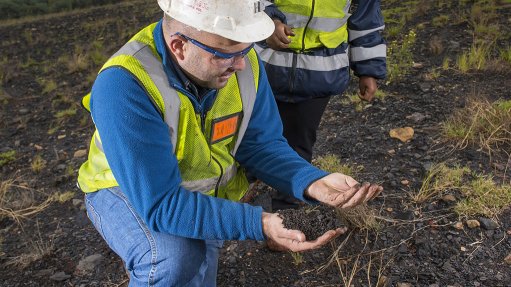
REHABILITATION WIN Fungcoal could eliminate or significantly reduce the need to lay down scarce topsoil and subsoils on opencast mined-out pits and discard dumps
The coal division of diversified miner Anglo American will focus on proving the long-term viability of its Fungcoal bioconversion technology by conducting trial tests of the technology in the near term, after which the company plans to implement it at as many of its operations as possible, Anglo American mine closure manager Henk Lodewijks says.
The coal miner also wants to expose regulators and other interested and affected parties to the technology so that it can gain acceptance as an alternative rehabilitation method for opencast- mined land and coal discard dumps.
While not an immediate priority, Anglo American Thermal Coal will consider the possibility of licensing this technology to third parties in the long term.
Fungcoal, a combination of the words ‘fungi’ and ‘coal’, is a process that harnesses fungi and weathered coal to produce natural fertilisers – a product that is regarded as the building block for soil fertility and plant life.
The bioconversion technology is being trialled at four Anglo American coal mines at a collective cost of R17.5-million, funded by the coal division in partnership with Rhodes University’s Institute for Environmental Biotechnology. The institute is the custodian of the microorganisms used in the Fungcoal technology and conducts the laboratory trials and monitors the sites at which the technology is being trialled.
The largest single trial site is a 10 ha site on a coal discard dump, where a Fungcoal, fertiliser and seed mix are applied directly onto discard coal. Another 10 ha site, where weathered coal and Fungcoal will be applied on subsoil for opencast rehabilitation, is being established.
Lodewijks says that, in certain applications, Fungcoal has shown “extremely” positive results on rehabilitated mining pits and coal discard facilities.
Fungcoal could potentially also significantly reduce the cost and improve the rate and quality of opencast mine rehabilitation, as the technology claims “to do in six months, or one growing season, what nature does in 60 years.”
If successful, Fungcoal could also eliminate or significantly reduce the need to lay down scarce topsoil and subsoils on opencast mined-out pits and discard dumps.
Fungcoal is based on the ability of naturally occurring nonpathogenic fungi to degrade low-grade coal in a process that involves colonisation through the production of oxidase enzymes that preferentially target polyaromatic hydrocarbons, breaking the heterocycles and introducing oxygen, explains Rhodes University Institute for Environmental Biotechnology director Professor Keith Cowan.
The products of this initial oxidation render the low-grade coal susceptible to further breakdown by other soil microorganisms, including fungi and bacteria.
The fungus used in Fungcoal technology is produced in mats on a solid medium and harvested at the spore stage. The spores are then introduced into an inert carrier material, such as clay, and then enriched with nutrients and several strains of plant growth to encourage the development of mycorrhizal fungi – a fungi that is essentially a biofertliser.
In ideal conditions of the correct atmospheric temperature and humidity typical of a spring/summer hydrological cycle, the spores of the coal-degrading fungi germinate and the growing mycelia act to colonise and degrade the low-grade coal, or carbonaceous substrate.
In the presence of germinating and growing grasses, including dicotyledonous species, the fungal mycelia attach to the roots and extend the root system of the plants to acquire and provide the nutrients required for plant growth.
The plant, in turn, produces exudate, or fluid, through its roots as it grows, which is the carbon source needed by plant-growth promoting rhizobacteria. Thus, a complete microflora develops in an otherwise inhospitable environment, says Cowan.
Rehabilitation is a long-term process and while the Fungcoal treatment will initiate low-grade-coal breakdown immediately, it is, however, critical that a mutualism is established between the coal-degrading fungus and the growing plant cover (grasses).
Consequently, any factor that negatively impacts on plant growth will reduce the efficacy of fungal coal biodegradation, says Cowan. “Assuming a good and healthy mutualism is established, soilification of the waste coal substrate will continue.”
While no additional microorganisms are needed in the current Fungcoal formulation, the Rhodes University’s Institute for Environmental Biotechnology has isolated several strains of coal-degrading bacteria that complement the coal-degrading fungus and enhance the process of low-grade-coal biodegradation.
Including the bacteria in the current Fungcoal formulation can, therefore, not only accelerate the process of soilification of low-grade waste coal but also enhance the revegetation of the sites, says Cowan.
“This means that the action of the Fungcoal catalyst produces conditions with a well-balanced supply of moisture for other microbes to inhabit. The microbes, in turn, further drive the rehabilitation, therefore making the biofertilisation of the waste coal being rehabilitated an ongoing self-perpetuating process,” he says.
Apart from being more cost effective in certain applications than traditional rehabilitation, the technology will enhance the quality of existing rehabilitation by increasing the organic content and the humic acid concentrations in the soil, thereby improving vegetation health and reducing soil compaction, says Lodewijks.
He says it will also conserve topsoil resources where the technology can be applied with subsoil or directly onto discard coal. Fungcoal can also transform some weathered coals and discards from waste into a suitable product.
It must be noted, however, that the technology will only be viable for rehabilitation of mined land where a source of suitable weathered coal is available in close proximity to the area to be rehabilitated, as the transport costs of the weathered coal – in instances where weathered coal acts as a substitute for organic matter naturally found in topsoils – may be high.